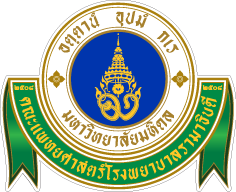เรื่องเล่าจาก ดร. สมรักษ์ สหพงศ์
ห้องสมุดคณะแพทยศาสตร์โรงพยาบาลรามาธิบดีตั้งอยู่ที่อาคารหลัก ชั้น 2 (ปัจจุบันคือ OPD ผิวหนัง) เปิดบริการพร้อมคณะฯ เมื่อ 2512 และใน พ.ศ. 2529 ได้ย้ายไปที่ อาคารเรียนรวม ชั้น5 เมื่อประมาณ หลังจากนั้น 20 ปี ใน พ.ศ. 2548 ได้รับคำสั่งจากผู้บริหารว่า ห้องสมุดจะได้ย้ายไปอยู่ตึกใหม่ แต่จำนวนพื้นที่ไม่แตกต่างจากตึกเดิม ซึ่งมีประมาณ 1,000 ตารางเมตร นับเป็นห้องสมุดโรงเรียนแพทย์ที่มีพื้นที่น้อยที่สุดในประเทศไทย การย้ายครั้งใหม่นี้เป็นการย้ายครั้งที่ 2 นับว่าเป็นเรื่องที่น่ายินดี


ภาพห้องสมุดเดิม
แต่โจทย์ที่ได้มาคือพื้นที่เท่าเดิมถึงอย่างไรก็ยังใจชื้นขึ้นเพราะท่านคณบดี(ศ.รัชตะ รัชตะนาวิน) ให้กำลังใจว่าทำให้เต็มที่ ขออะไรก็ได้ (ยกเว้นพื้นที่ซึ่งมีจำกัด) ขอให้ทำให้ห้องสมุดทันสมัยและสวยงาม ท่านพร้อมจะสนับสนุน พวกเรารู้สึกดีใจแต่เราต้องหาทางที่จะไปให้ถึงฝันให้ได้
ห้องสมุดคณะฯ ได้พื้นที่ ณ ชั้น 2 ของอาคารเรียนและปฏิบัติการรวมด้านการแพทย์และโรงเรียนพยาบาลรามาธิบดี พวกเราต้องหาข้อมูลต่างๆ โดยด่วนเพื่อมาประมวลให้เกิดเป็นห้องสมุดแห่งใหม่ โดยการศึกษาดูงานทั้งการไปดูพื้นที่จริง และการดูทางเว็บไซต์ รวมทั้งวิธีการต่างๆ เพื่อประสานงานกับสถาปนิกและผู้ออกแบบตกแต่งภายใน จนกระทั่งในปี พ.ศ. 2551 เริ่มมีการก่อสร้างจนกระทั่งสร้างเสร็จ และตกแต่งสำเร็จใน พ.ศ. 2553 และให้เข้าใช้ได้ตั้งแต่ วันที่ 27 ธันวาคม 2553

ภาพห้องสมุดปัจจุบัน
การย้ายห้องสมุดสิ้นสุดลงอย่างภาคภูมิใจที่เราไม่ปิดบริการเลย นับเป็นห้องสมุดแห่งหนึ่งที่ย้ายพื้นที่บริการโดยไม่มีการปิดบริการ


การจัดสร้างห้องสมุดคณะฯนี้เรามีหลักการที่สำคัญในการปฏิบัติงานครั้งนี้ที่เราภาคภูมิใจอีกเช่นกัน คือการใช้แนวคิดของ การปฏิบัติงานทางบรรณารักษ์และสารสนเทศเชิงประจักษ์ ( Evidence-Based Librarian and Information Practice-EBLIP) หรืออาจเรียกว่า Evidence-Based-Librarianship (EBL) ซึ่งเป็นแนวคิดใหม่ของนักสารสนเทศ
นับเป็นเวลามากกว่า 10 ปีที่นักสารสนเทศนานาชาติให้ความสนใจกับการนำหลักฐานเชิงประจักษ์มาใช้ในกลุ่มบรรณารักษ์และสารสนเทศ เช่น ประเทศสหรัฐอเมริกา ประเทศแคนาดา ประเทศสหราชอาณาจักร ประเทศออสเตรเลีย และประเทศต่างๆในยุโรป รวมถึงในเอเชีย เช่น ประเทศฟิลิปปินส์ เป็นต้น ซึ่งการนำหลักฐานเชิงประจักษ์มาประยุกต์ใช้ในวิชาชีพนักสารสนเทศนี้ เป็นที่รู้จักกันในคำว่า Evidence-Based Librarian and Information Practice หรือ EBLIP อย่างไรก็ตาม Evidence-Based Librarian and Information Practice หรือ EBLIP ยังไม่ได้รับการบัญญัติศัพท์ภาษาไทยที่แน่นอน แต่ผู้เขียนขอใช้ภาษาไทยว่า การปฏิบัติงานทางบรรณารักษ์และสารสนเทศเชิงประจักษ์ กระบวนทัศน์ใหม่ของวงการบรรณารักษ์และสารสนเทศนี้เป็นระบบและเป็นประเด็นที่นักสารสนเทศนานาชาติกำลังให้ความสนใจและมีการขยายแนวคิดนี้ไปทั่วโลกในระยะเวลาอันใกล้นี้
จากการใช้แนวคิดการปฏิบัติงานทางบรรณารักษ์และสารสนเทศเชิงประจักษ์ จึงได้ส่งผลงานไปนำเสนอที่ A-LIEP 2011: Asia-Pacific Conference on Library & Information Education and Practice- Issues, Challenges and Opportunities วันที่ 22-24 June 2011. ดังนี้
เรื่อง Evidence-Based-Librarianship (EBL) : for new place of Ramathibodi Medical Library.
By Dr. Somrux Sahapong. Ramathibodi Medical Library. Mahidol University. Thailand.
Setting: Ramathibodi Medical Library is the most small medical school library in Thailand due to the most limitation of space in Ramathibodi Medical School. The budget has been approved to renovate the new place for the library but the staff should concern the same size.
Methodology: The library staff conducted the Evidence-Based-Librarianship (EBL) concept in to the right practice for the new building. We define the problem as: For new library building which limit the space but still providing the splendid service. We formulated the answering prediction question using SPICE model in causation question type. The evidence in the management has been searching via LISA Database, ISTA Database, Emerald Database, INSPEC Database including PubMed Database. Critical appraising the evidences are required to realize the validity reliability and applicability.
Result: The majority of evidences are applicable as the following: decrease the bound print volume with scanning technique, the reading areas are dedicated for special internal service. The architect designed the special thick floor and high ceiling for the new building and the special high heavy stable shelves for books and journals. Furthermore, the special high compactable shelves are suitable to be allocated.
Conclusion: The new building of Ramathibodi Medical Library were embarked for one and a half year. Finally, the library with the same size, high technology tool and electronic format included online databases applicable are presented in the new building. The launching high technology service via online were conducted. The reading area is conversed into internal service contact. Nevertheless, the living library are still in Ramathibodi Medical Library concept.
